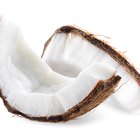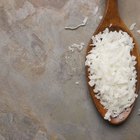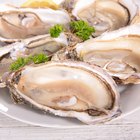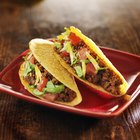
As strange as it sounds, eggs, snails and coconuts have something in common: they all come with their own cooking vessel. Coconut shells work for steaming coconut meat and rice because they're waterproof and separate cleanly into bowls if you open them along the seam between the halves. You can serve the rice in the bowls along with chilis, coriander, peanuts and coconut meat to make thengai saddam, a South Asian favorite, or turn the rice out onto a plate of curry for an expertly molded chiratta puttu, a popular South Indian side dish.
Step 1
Refrigerate the coconut for about 1 hour to make opening easier. Poke a hole in the largest "eye," or depression, at the axis of the coconut with a chopstick or screwdriver, then drain the milk into a bowl.
Step 2
Place the coconut on the work surface and locate the seam that runs between the "eyes." The seam circumscribes the coconut at the halfway point, and you have to tap the coconut on the seam for the shell to split cleanly.
Step 3
Tap the seam on the coconut with the blunt edge of a meat cleaver or chef's knife. If using a chef's knife, wrap a towel around the blade so you won't cut your hand.
Step 4
Rotate the coconut while you tap it along the seam. When you hear a crack instead of a thump, the shell has started to split. Continue tapping along the seam until the shell splits cleanly.
Step 5
Scrape the meat from the coconut with a paring knife and set it aside. Leave about 1/4 inch of meat in the shells if you want to incorporate a pleasant coconut flavor to the rice. Store leftover meat in a food-storage container in the refrigerator up to 3 days.
Step 6
Rinse the rice for several minutes in a sieve under cool running water to get rid of the powdery starch.
Step 7
Fill a baking dish with about 1 inch of dried beans. Heat the oven to 350 degrees Fahrenheit.
Step 8
Pour about 1 cup of rice in the half of the coconut shell that doesn't have the "eye" poked out of it. Nestle the coconut shell in the dried beans in the dish.
Step 9
Bring 2 cups of water to a boil in a kettle or saucepan. Pour the boiling water over the rice.
Step 10
Cover the coconut shell with a few layers of aluminum foil and place the rice in the oven.
Step 11
Bake the rice for 30 minutes and take it out of the oven. Wait a minute or two for the shell to cool down enough to handle.
Step 12
Season the rice to taste with kosher salt and add shredded or sliced coconut meat, if desired. Serve the rice in the shell or invert it on a plate and remove the shell to have a molded mound of rice.
Related Articles

How to Dry Coconut As a Snack Food

How to Clean Out & Dry a Coconut Shell

How to Remove the Shell From a Coconut

How to Cook Coconut-Crusted Tilapia ...

How to Cook Nigerian Coconut Rice

Pairing With Coconut Rice

How to Make a Coconut Bra

What Does It Mean if a Coconut Smells ...

How to Ferment Coconut

How to Put on a Coconut Bra

How to Cook Rice in Foil

How to Cook Steamed Rice With a Bamboo ...

How to Toast Fresh Coconut

How to Cook Fresh Oysters to Make Stew

How to Cook Oysters on the Stove

How to Clean a Coconut

Nutrients and Fiber in Coconut

How to Freeze Fresh Raw Coconut

How to Cook Japanese Rice

Calories in Hard Taco Shells
References
Tips
- You can also bake the coconut shell after you open it in a 350-degree-Fahrenheit oven for 10 minutes to make removing the flesh easier.
- If you have a pressure cooker, you can set the coconut shell of dry rice on the lid by inserting the vent pipe through the hole in the coconut shell. Set a plate on top of the coconut shell to act as a lid, and simmer water in the pressure cooker for about 30 minutes to steam the rice.
- Add cooked fish or shrimp if you're serving the rice in the shell for an all-in-one meal.
- Garnishes and other finishing ingredients that go well with coconut rice include toasted cashews, red chilis, coriander and sliced bananas.
Writer Bio
A.J. Andrews' work has appeared in Food and Wine, Fricote and "BBC Good Food." He lives in Europe where he bakes with wild yeast, milks goats for cheese and prepares for the Court of Master Sommeliers level II exam. Andrews received formal training at Le Cordon Bleu.
Photo Credits
Hemera Technologies/AbleStock.com/Getty Images